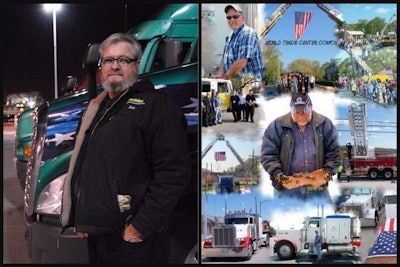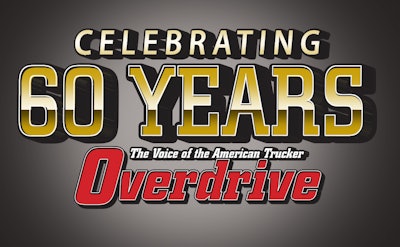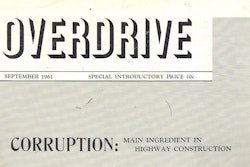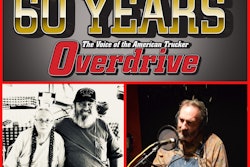
Given the national observance of the 20th anniversary of the 9/11 attacks this past weekend, this week's Overdrive 60th-anniversary installment takes a look back at my own contribution to post-9/11 trucking history, originally penned on the 2011 occasion of the 10th anniversary. Impacts of that event are impossible to exhaustively chronicle, yet at the time we found significant shifts in security protocols throughout the business of trucking in all manner of supply chains, a renewed sense of driver camaraderie (with significant exceptions) and a mixed bag of outcomes on the business side when it comes to freight.
What was decidedly not mixed is evident in how the piece begins – everyone we spoke to to a man and woman could well recall just exactly where they were when they heard the two World Trade Center towers had been struck. Given the decade gone by since then, that's no doubt no longer true for many of the youngest trucking industry participants.
But for those among you for whom it is, we'll ask you again: Where were you when you heard the news? Drop us a comment at bottom or reach out to me directly – we'll round up some of the responses in a follow-up piece.
And note: The following piece originally appeared in Overdrive and sister Truckers News magazines in 2011 – it has been lightly edited to reflect the reality of time gone by – with the following title:

Lasting legacy | 9/11 special report
Florida-based owner-operator Tim Philmon was sitting in his 2001 Mack Vision at a shipper near the Miami airport. He and several other drivers he knew were waiting to load when they heard the first plane had flown into the World Trade Center’s North Tower that morning.
“One of the guys had a TV in his truck,” Philmon said, “and we were watching, trying to figure out what was going on,” when the second plane flew into the South Tower. Soon, Philmon noticed a dearth of planes in the sky.
In Dallas, then-Prime-leased owner-operator Mike Crawford noticed the empty skies, too, during a pick-up of shingles. “The planes were going over to Love Field in Dallas and, all of a sudden, there were no planes. I got loaded and got out of there and was going to stop in Ana, Texas, at the Love’s to get some fuel.”
Twenty miles from the stop, Crawford received a call from his wife, who was in tears. “She wanted to know where I was, what I was doing. ‘Be careful, be careful,’ she said, then telling him what had happened. “I said, ‘Honey, they aren’t going to blow up a load of shingles.'"
When Crawford, a Marine veteran of the Vietnam War, saw the Pentagon had also been hit, he thought about his Army nephew, who worked at the facility.
Bettina Cameron was hauling team for Covenant Transport at the time. They had delivered in Long Island on Sept. 10 and were dispatched to Milton, Pennsylvania, to load the next morning. “Our dispatcher woke us up,” Cameron says, “wanting to know if we heard the news.” They watched the South Tower being hit.
Perkins Specialized-leased owner-operator Dick McCorkle, meanwhile, was stuck in a warehouse in Manhattan, backed into a shipping facility at 42nd Street and Seventh Avenue “when the lights went out,” he said. “They used emergency lighting to open the door and let me out, but there was nowhere for me to go” — 42nd Street was completely shut off; traffic lights weren’t working. All emergency units (including all police and fire departments) were headed to Lower Manhattan.
“People approached my truck multiple times to see if I could get any information on my radio, but at this point even my CB was useless,” he said. “Cell phones were down. I could barely talk to the people across the street.”
At the 10th anniversary of 9/11, Overdrive and sister magazine Truckers News took stock of how the event changed the industry, from camaraderie among drivers to regulations and business, for better and worse.
Driver camaraderie
The 9/11 attacks brought the country together at a time of waning national coherence. “I think it was so good to see the flags and the camaraderie as we all pulled together,” Cameron said. “As time has gone by, though, we’re sort of losing that again. We need to remind ourselves that we’re all Americans; we’re all in the same boat.”
Crawford believes driver camaraderie in 2011 remained better than it was before the attacks, but more importantly, drivers were more committed to preventing criminal activity on the road. “There’s an awareness now of guys just out there watching,” he said, referencing the Washington, D.C., sniper, who murdered 10 people over a three-week span a year after 9/11.
Ron Lantz, one of the truck drivers who aided police in apprehending John Allen Muhammad and Lee Boyd Malvo at a Maryland rest area, was “paying attention,” said Crawford, just as his driver compatriots continue to do. “Guys are listening — when the media puts out a call for somebody, they’ve got our attention — not just for terrorist activity, but for any criminal activity.”
Walt Fountain, in 2011 director of enterprise security at Schneider National, said training and communication improved following 9/11. “We work diligently to make sure we have a good flow of information to our drivers and receive good information from them,” he said. “Drivers have stayed vigilant and are not afraid to call 9-1-1, look for anomalies and regularly inspect their truck and trailer. The same tools that can prevent cargo theft are also used to prevent terrorism.”
Official recognition of drivers’ post-9/11 on-highway awareness led to programs offering further training in crime prevention, such as the First Observer initiative (www.firstobserver.com) with a single hotline number for on-highway watchers to report suspicious activity. Bill Arrington, general manager for the motor carrier division of the Transportation Security Administration in 2011, then estimated truckers made 50% of the calls under the program, which replaced the Highway Watch program that was launched after 9/11. He said awareness was increasing among all transportation workers, including truckers and bus drivers.
Philmon contended that the 9/11 attacks, perpetrated by individuals living freely and in large part legally within the United States, eroded camaraderie as drivers became suspicious of one another. “You used to run around in groups, but everybody stays more to themselves today,” he said. “You don’t know who you’re talking to on the CB radio. You read about guys getting killed due to lack of parking — you have to be very careful who you talk to.”
But Cameron contended that heightened awareness post-9/11 means “people are more cautious,” she said, “but that’s to me where the camaraderie comes in. If I see somebody messing around with someone else’s truck, I’m more likely to say, ‘Hey, what are you doing?’ You’re more likely to look out for the next guy.”
Todd Spencer, now president of the Owner-Operator Independent Drivers Association, said in 2011 some shippers and receivers “are more aware and following more specific procedures to make certain security is adhered to and limiting access to their facilities. At others, drivers tell us, nothing has changed.”
Freight: Some won, some lost
Cameron and her husband, Brian, spent a year and a half post-9/11 hauling in a new niche, military freight, leased to Covenant Transport. It was a lucky post in that demand for team haulers with spotless backgrounds to run for the Department of Defense soared after the attacks put the country on a war footing. On 9/11, after the Camerons had talked to their dispatcher and had seen what happened, they received another call from the office: “They needed to know if we could get clearance to haul military hauls from one undisclosed location to another,” she said.
They were already hauling high-value freight that required background checks, so “we told them we figured we could get background clearance,” Cameron said. “We took our load that morning on to Portland, and when we got there they told us our clearance had gone through. For that next year, you’d go to a base and people would meet you and cloud out your side windows — sometimes they’d leave you in your truck, sometimes they’d take your truck, unload or load it, and bring it back to you.”
The Camerons were busy through the recession that grabbed the national economy after 9/11, well into 2003. It wasn’t the same for everyone, though. McCorkle, while he doesn’t recall struggling for freight following 9/11, saw his bread and butter hauls, into and out of New York City hauling trade show freight, dry up quickly. “Business within New York City is just not there anymore, for me,” he said in 2011. “9/11 changed everything out on the East Coast. Business moved out of New York, out of New Jersey; well inland.”
Avoiding cities became more of a priority for McCorkle, he said, after his experience in New York that day. “My nerves were pretty well shot there for a while.”
One group impacted by the 9/11 aftermath is haulers of air freight, Fountain said. “You look at the screening, the control over drivers selected to move that freight and the training and background checks they’re required to have — clearly that has been driven a lot by 9/11 and the concern over terrorism in our country and targeting of air cargo and passenger systems.” Spencer added that one OOIDA member said he had taken specialized training to handle air freight authorized by the Department of Homeland Security.
Operational problems following 9/11 came into play as cities around the country required trucks take bypass routes around their towns, adding costs for carriers and drivers in miles. From New York City itself to the 75-mile diversion around the Hoover Dam before the truck bypass bridge was finished almost a decade later, mandatory truck diversions likely contributed to the shifting pay landscape late in the first decade of this century as carriers competed more fiercely for drivers, offering practical-miles pay packages to more accurately reflect actual miles driven.
Security changes
Tractor-trailers have been used as instruments of terror in other countries. In the United States, box trucks packed with explosives were used in the 1990s Oklahoma City bombing as well as the World Trade Center bombing.
Asked about how 9/11 changed trucking, Jay Thompson, president of Transportation Business Associates and longtime trucking industry participant, in 2011 recalled the then-lone instance of use of a tractor-trailer as a weapon of attempted mass slaughter, when a “refrigerated truck was rammed into a California government office in January 2001. That has been the only deal where a commercial truck was used as a tool of mass destruction, although only the driver was killed.”
“Truckers are looked at with hard scrutiny,” Philmon said. “It changed from that day forward. You’re not as free as you were out here prior to 9/11.”
The Transportation Worker Identification Credential emerged from the Maritime Transportation Security Act of 2002 that was started in 2007 and fully implemented in 2009. It aimed to identify persons such as truckers who require access to maritime facilities, such as ports. The program requires a background check and tamper-proof identification card that includes the holder’s fingerprints.
The program in 2011 and to this day had its critics. A Government Accountability Office report claimed the program had poor internal controls and oversight during a 2007-10 examination. A TSA official then said the GAO “found that these weaknesses could have contributed to the breach of facilities that occurred during GAO’s covert testing.”
From the cardholder’s standpoint, the proliferation of security programs by individual ports, shippers and other organizations requiring background checks, fingerprints and photo ID is redundant and “fraught with waste and expense for drivers,” Spencer said in 2011. “Congress has yet to mandate a system of background checks for drivers that makes sense.”
For example, hazardous materials haulers have faced increased post-9/11 scrutiny, according to John Conley, then-president of the National Tank Truck Carriers. “Prior to 9/11, hazmat [licensing] was a knowledge test,” he said. “All of a sudden the hazmat knowledge test became a character test. Now you have to supply the same information more than once if you want a TWIC to go into certain areas. It’s increased the hassle factor.”
Getting trucks, drivers and freight into the country for companies in our border nations north and south — and getting drivers back into the country from the north — was significantly impacted by the heightened sense of security. “The Customs-Trade Partnership Against Terrorism,” an effort by the United States and international partner companies and nations to further secure the supply chain from terrorist infiltration, “came about from a total tightening of the border post-9/11,” Thompson said. As incoming traffic slowed dramatically due to checks by agents of multiple agencies, from “Customs and Border Protection to the DOT to even USDA and the Environmental Protection Agency,” he added, the C-TPAT was launched and promoted as a way for the shipping and carrier communities to achieve quicker access to the U.S. interior by undergoing verification and inspection procedures all along every point of their supply chain by U.S. agents.
That program, too, said Thompson, has come under criticism as an initiative that has realized little of its potential. “The vast majority of freight across the border is not C-TPAT freight,” Thompson said in 2011.
Another program that emerged after 9/11 was the Highway Watch initiative to encourage truckers and others to report on-road suspicious activity. In 2010, the program was replaced by the First Observer program, with a new manager.
While Highway Watch was supported by carriers and their organizations, First Observer had the backing of the Teamsters Union and OOIDA.
Fountain says that though usage of security technology such as GPS tracking increased over this century's first decade, he didn't link it specifically to 9/11. “Obviously, 9/11 did have an impact on trucking, but a whole lot more has happened in recognition of the value in taking security precautions and the value of new technology in operations,” he said.
9/11 Aftermath
In the final analysis, 9/11 was a momentous event that changed the lives of some truckers forever. Mike Crawford found out his nephew in the Pentagon had suffered a broken arm and a broken leg in the attack but realized a renewed sense of patriotism and anger toward the hijackers that “pissed him off so much he reenlisted,” said Crawford.
Several members of driver Bettina Cameron’s family joined military services as well. She felt like she was doing her national duty “just being a trucker” during a time of trial. “All the planes were down — the only way that things were moved was by truck. It was almost like, ‘You might take the planes down but it doesn’t matter, we’re just going to keep going. I took pride in the trucking industry. For me, it was like I was doing something important, too, for my country.”
Tim Philmon, leased to Landstar, got the rare opportunity to haul steel from the World Trade Center in early 2010, part of a 28-truck Landstar convoy from a hangar at JFK International Airport to the National Iron and Steel Heritage Museum in Coatesville, Pennsylvania. “It was the haul of a lifetime,” he said at the time.
Philmon was hoping to deliver one of many loads of steel intended for the Freedom Tower at the World Trade Center site, in 2011 under construction, putting a personal cap on the 9/11 legacy.
By dawn on Sept. 12, 2001, Dick McCorkle was finally able to get out of Manhattan to Connecticut, where he called his wife in Indiana. He told her he was OK and “that I knew it would be a while before I could get home.”
About a week later, he said, “I returned to the job I had started out of East Greenfield, Pennsylvania, and headed back for New York. Everything had changed. The National Guard and policemen were patrolling each and every stop light, and every entrance into the city. The place where the World Trade Center used to be was still smoking. Cleanup had started, but it was a slow process. The mayor of New York and the President had their hands full.
“After I delivered in New York City, I went to Long Island to pick up another load. It was a trade show headed for Las Vegas. I got to Springfield, Missouri, before I was told to return the load, since all trade shows had been canceled. After I returned the trade show, I went back to East Greenfield to make yet another run into New York. The people who had been receiving my loads weren’t there. They had been replaced by an entirely different crew.
“About a month after the attack, business out of East Greenfield had slowed drastically and I relocated. To this day I don’t know whether or not those that had been unloading me made it through the ordeal or not. I’ve never seen them again.”











